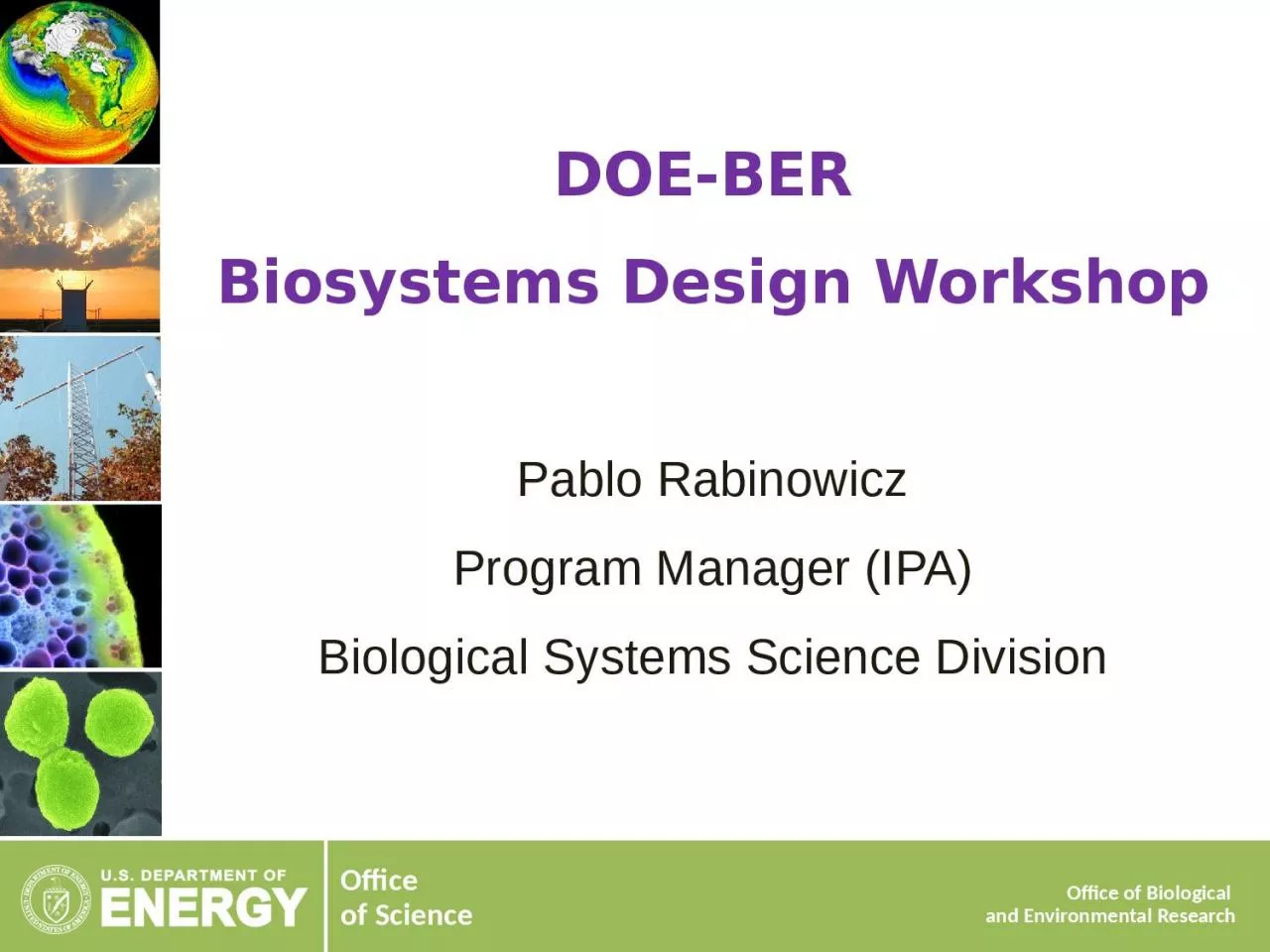

Workshop Pablo Rabinowicz Program Manager IPA Biological Systems Science Division BER Genomic Science Program The Genomic Science program underpins the development of biotechnology solutions for energy the environment and carbon sequestration The support of fundamental research on microb ID: 1007103
Download Presentation The PPT/PDF document "DOE-BER Biosystems Design" is the property of its rightful owner. Permission is granted to download and print the materials on this web site for personal, non-commercial use only, and to display it on your personal computer provided you do not modify the materials and that you retain all copyright notices contained in the materials. By downloading content from our website, you accept the terms of this agreement.
1. DOE-BER Biosystems Design WorkshopPablo RabinowiczProgram Manager (IPA)Biological Systems Science Division
2. BER Genomic Science ProgramThe Genomic Science program underpins the development of biotechnology solutions for energy, the environment, and carbon sequestration. The support of fundamental research on microbes and plants emphasizes understanding systems biology across multiple scales of organization from the molecular, cellular, to the community and ecosystem level. The goal is to gain insights about fundamental biological processes and, ultimately, a predictive understanding of how living systems operate, to enable functional design of biological systems for DOE mission needs. Program Objectives Determine the genomic properties, molecular and regulatory mechanisms, and resulting functional potential of microbes, plants, and biological communities central to DOE missions.Develop the experimental capabilities and enabling technologies needed to achieve a genome-based, dynamic system-level understanding of organism and community functions.Develop the knowledgebase, computational infrastructure, and modeling capabilities to advance the understanding, prediction, and manipulation of biological systems.
3. BERAC 2010 Long-Term Vision ReportPrioritize research to enable functional characterizations of systems and synthetic design“By integrating withcomputational science, synthetic biology can enable the design and construction of essentially new materials, organisms, pathways, or information processing Systems”
4. BER Biosystems Design WorkshopJuly 17-20, 2011Bethesda North Marriott HotelPablo Rabinowicz, Workshop OrganizerTodd Anderson, Former Acting Division Director, BER-BSSDJoseph Graber, Program Manager, BER-BSSDSusan Gregurick, Program Manager, BER-BSSDShireen Yousef, Scientific Program Specialist, BER-BSSDSupport from ORISE
5. BER Biosystems Design WorkshopGenomics and systems biology approaches to study microbes and plants from the molecular to the community scale lead to comprehensive understanding of fundamental biological processes, ultimately allowing us to predict the behavior of a given biological system under changing conditions. Such predictive knowledge will permit the design and re-engineering of biological systems for specific purposes. New biodesign tools and technologies will in turn help understand natural systems and their response to change. DOE-BER seeks to support biosystems design research aimed at tailoring microbes, plants, and their communities to advance clean energy and environmental solutions Identify general biological design principlesDevelop new synthetic molecular toolkits to design, construct, and test new, multi-scale natural and hybrid biological systems
6. George ChurchHarvard U.Workshop ParticipantsAdam ArkinLBNLMaciek AntoniewiczU. of DelawareSarah AssmannPenn State U.Shota AtsumiUC DavisNitin BaligaInst. for Systems Biol.Scott BantaColumbia U.Christoph BenningMichigan State U.William CannonPNNLKelly DaweU. of GeorgiaDavid GangWashington State U.John GlassJCVIRamon GonzalezRice U.Peter GreenbergU. of WashingtonErich GrotewoldOhio State U.Adam GussORNLChris HenryANLKristala Jones-PratherMITJay KeaslingLBNLMattheos KoffasSUNY BuffaloCostas MaranasPenn State U.June MedfordColorado State U.Basil NikolauIowa State U.Gary SaylerU. of TennesseeVipula ShuklaDow AgrosciencesChristina SmolkeStanford U.Gary StaceyU. of MissouriKechun ZhangU. MinnesotaJames LiaoUCLAEdward EisensteinU. of MarylandJennifer ReedU. of Wisconsin Co-Chairs:
7. Observers from Other Offices and Federal AgenciesNational Science FoundationNational Institutes of HealthU.S. Department of AgricultureDepartment of DefenseDefense Advanced Research Projects AgencyOffice of Science and Technology PolicyDOE Office of Energy Efficiency and Renewable EnergyDOE Office of Basic Energy Sciences
8. Workshop StructurePlenary sessionSpeakers (S. Assmann, A. Arkin, G. Church)Breakout sessionsBiological Design Principles Strategies, Methodologies, and Approaches for the Design of Biological Systems Predictive Biology at the System Level Plenary sessionBreakout Leads’ PresentationsWriting session Co-Chairs only
9. Charge QuestionsBreakout Session I: Biological Design Principles 1) What are the fundamental principles and approaches that are needed to enable the facile design of molecules, modules, organisms and communities? 2) What critical information is needed for biological systems (interactions among biological modules and processes, structures, mechanisms) to provide a robust foundation for biological design? 3) What are the biological concepts that must be understood to integrate hierarchical modules to generate more realistic/complex/useful functions of engineered biological systems?
10. Breakout Session II: Strategies, Methodologies and Approaches for the Design of Biological Systems 1) What useful models could help establish general approaches for the design of complex biological systems at multiple levels of complexity (microbes; unicellular plant, e.g. algae, cell cultures; bioenergy crops; microbial communities; microbial-plant communities)? 2) What are the key gaps in our knowledge and what technological approaches are needed to design novel biomolecules, microbes, plants, and communities for specific purposes? 3) How can evolutionary processes be harnessed to accomplish forward engineering of biological systems from the gene to the community level?4) What considerations of evolutionary or ecological dynamics are needed to effectively engineer systems with sustainable functionality?Charge Questions
11. Breakout Session II (continued):5) How can cellular communication modules (intra- and/or inter-species) be used to coordinate and control synthetic systems?6) What is needed to more fully integrate systems biology approaches to inform biological design principles? 7) What is the role for computational biology in the design of novel biological systems? 8) What computational biology tools are needed to facilitate design of molecules, networks, cells and communities?9) To what degree is compartmentalization (cellular, organismal, community) important for developing designed biological systems?10) What critical data is needed to advance the design of biological systems? Charge Questions
12. Breakout Session III: Predictive Biology at the System Level 1) What is on the short-, mid- and long-term horizon for biological design that would advance bioenergy, bioremediation and climate change research? 2) What are the basic and applied goals that bio systems research should pursue?3) What major outcomes could be expected from research on biological design over the next decade? Charge Questions
13. Biological Design PrinciplesMolecules, modules, organisms, communitiesBiological Design Strategies, Methodologies and Approaches Design from scratchCombine parts and modulesModel systemsComputational biologyFuture PerspectivesSystems Biology KnowledgebaseSustainability of synthetic systemsDiscussion TopicsT A AU T T
14. Thank you